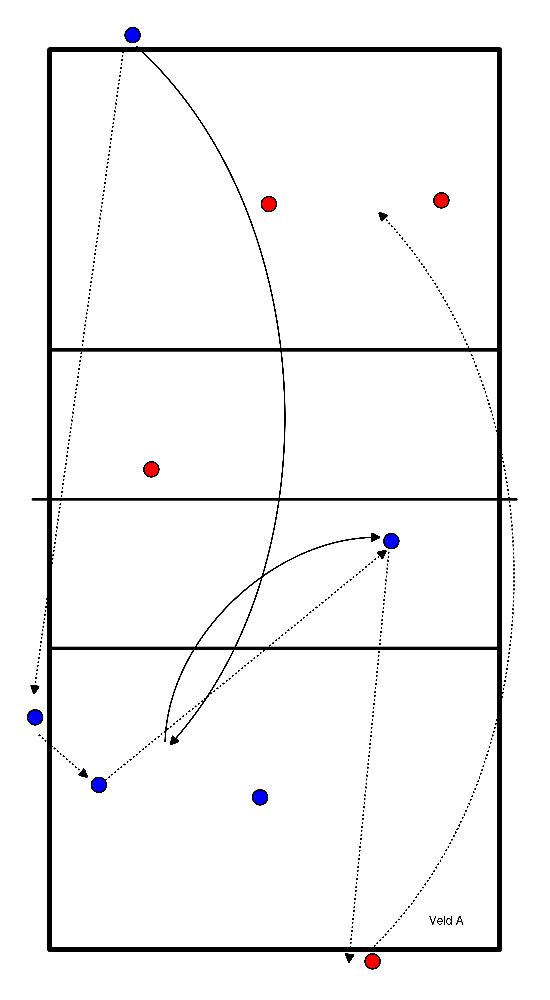Volleyball drills for technique passing / defense / reception
- 1 server, on the other side of the field 3 passers, with behind them again 3 passers who are ready.
- The server taps the ball, the passers run to the middle line, run backwards and the server serves.
- Play 3 times, everyone on the field.
- Change positions.
- Then with back to server, taps the ball, passers run into the field after which the server serves.
- Trainer throws-serves ball to passer.
- A passes ball to midfield position.
- B stands at the basket and catches the ball and brings it to the trainer and then joins the back of the line.
- A becomes B.
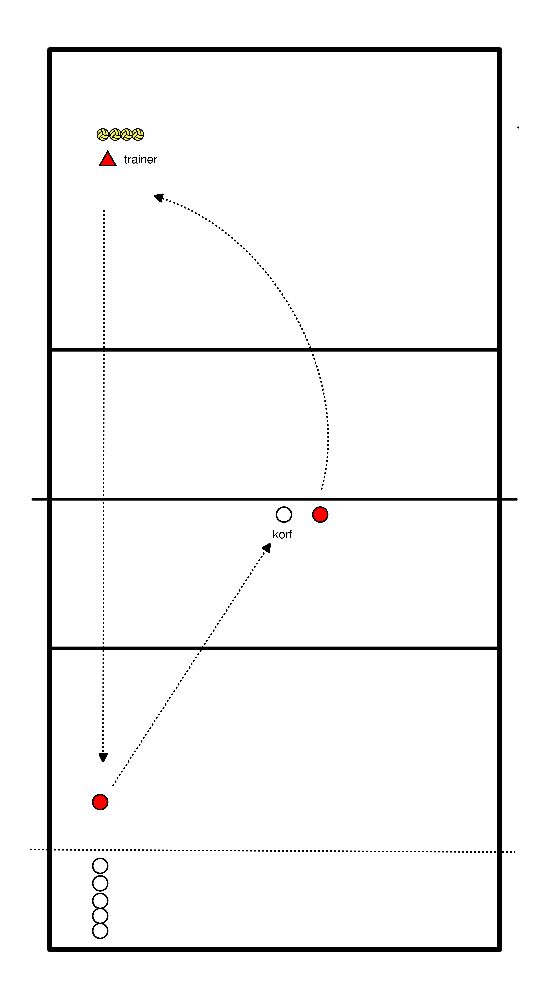
- There is one passer in the field at position [6].
- The trainer or a playmaker stands with the balls at the net at position [3].
- The ball is introduced by hitting or pricking and there is a variation in short/long and hard/soft.
- The passer keeps the ball from the ground (prio 1) and provides the pass to [2/3] (prio 2) where the ball is caught by a team mate.
- This exercise can be played in two variants.
- A. [suitable for large teams]
- After the pass, a new player is rotated into the field and the passer joins the back of the line.
- High tempo!
- The team can be split in two, so that one team always picks up the balls from the other team.
- B. [suitable for small teams]
- The passer remains standing.
- He quickly takes up his position again after the pass and processes a new ball (10 in total).
- The other players spread out to collect the balls.
- After 10 passes the passer takes off and the ball is passed.
- High tempo!
- Explanation:
- 2 teams of 3 players
- Per team 3 volleyballs (different balls so you can tell the difference, 2 'baby' and 1 'normal' ball)
- The team must play the 'normal' ball over the net in 3 times and meanwhile the 'babies' are thrown over.
- Each player may only touch the 'normal' ball once!
- (When a player has played the 'regular' ball, he gets a 'baby' thrown to him)
- Starting positions:
- Mid-back has no ball. Mid-back has no ball (he passes the ball to the distributor).
- Distributor gives a set-up on the outside.
- 3rd player plays the ball over the net. (At first do not attack, only if it goes well!)
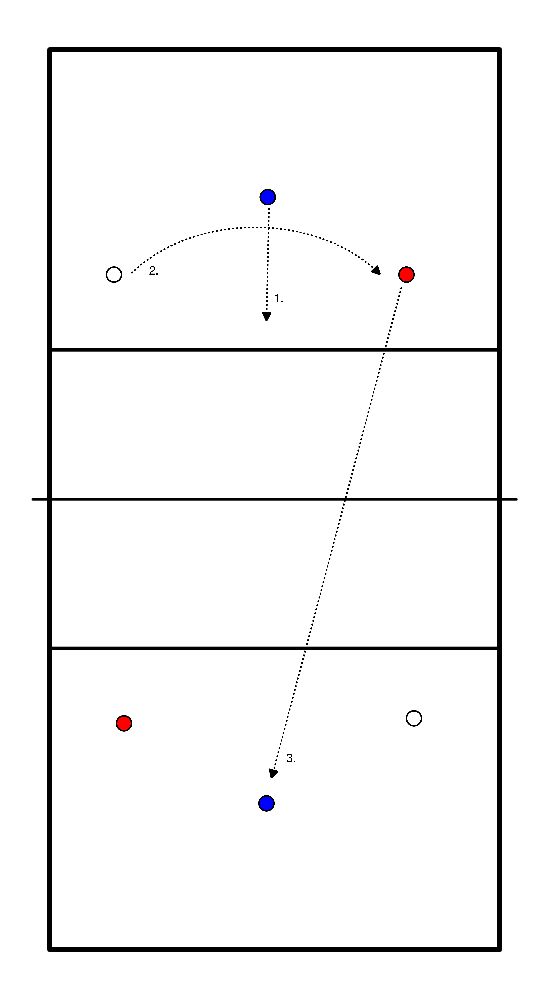
- The goal is to play the ball in threes. This requires the commitment of every player.
- So line up three players.
- They solve a thrown ball (by the trainer), by playing in threes.
- The first ball is passed to the upper-position.
- The 2nd player, who has the job of upper-player, runs to the upper-place.
- The 3rd player then prepares for the attack.
- At first keep the ball on one side of the net, by not actually hitting the 3rd ball, but catching it.
- Then 3 other players move in to do the same.
- On the other side of the net, the same is practiced with the other half of the team.
- After a while, when the ball is regularly played in threes, the ball is actually played to the other side.
- The team on the other side then plays the ball back in threes.
- And so on; play over as long as possible.
- No scoring, it's about playing in threes.
- Organisation: Make three teams with one ball.
- Execution:
- 2 players stand opposite each other at approx. 5m.
- The third player is "distributor" and stands to the right of the passer.
- Player 1 plays brace to 2nd player and he passes the ball to the right, where the Sv is standing.
- This gives player 2 a setup, which is attacked on player 1.
- Meanwhile, Sv runs to the right side of player 1 to receive the pass there.
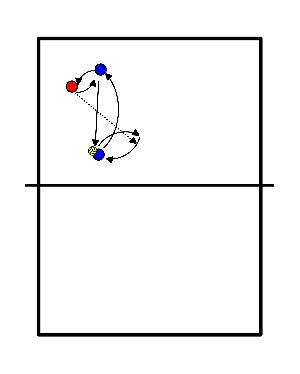
- Ball at the net, player on the back line.
- Short ball, 3 metres.
- Shuffle back.
- Long ball 7 meters.
- 6 short balls.
- 5 long balls.
- Last short ball is pancake.
- Important:
- First walk (arms loose and not extended), then stretch and pass.
- Stand still when passing but continue the exercise.
- Throwing (2 players at the same time)
- Move from the left- and right-back to the middle 3-meter and pass; 8 balls 7.
- From left and right back to front 3-meter move and pass; same side 7 balls.
- From left and right halfway side-shuffle. Pass in the middle; same side 7 balls.
- Block at the net and then pass on 3-meter line; same side 5 balls.
- From midfield to left- and right-back bring shuffle pass; loop 5 balls.
- Hit (4 at the same time):
- From left side (3-meter) 1st ball from center attack directly on player; shuffle towards mid-back with immediately a slide attack from outside position.
- From position 5 direct middle attack on player; shuffle to position 6 ball thrown in.
- From position 5 direct mid-attack on player; shuffle to position 4 ball thrown in.
- From the right side (3-meter) 1st ball from mid-attack directly on player; shuffle towards mid-back with immediately a slide attack from the outside position.
- Extended (3 at a time):
- From right long ball from outside attack; short shuffle for diagonal attack. (left player right player alternate)
- 3 passers with random balls. (attack, throw, long balls, short balls)
- Players form threesomes.
- Per trio two players at the net with a ball.
- Player A hits the ball (overhand) for a pass before the backline.
- Immediately after that B throws the ball on the three meter line.
- Player C makes a pancake and plays the ball back.
- After 10 times the players turn one spot (A becomes C, B becomes A, C becomes B).
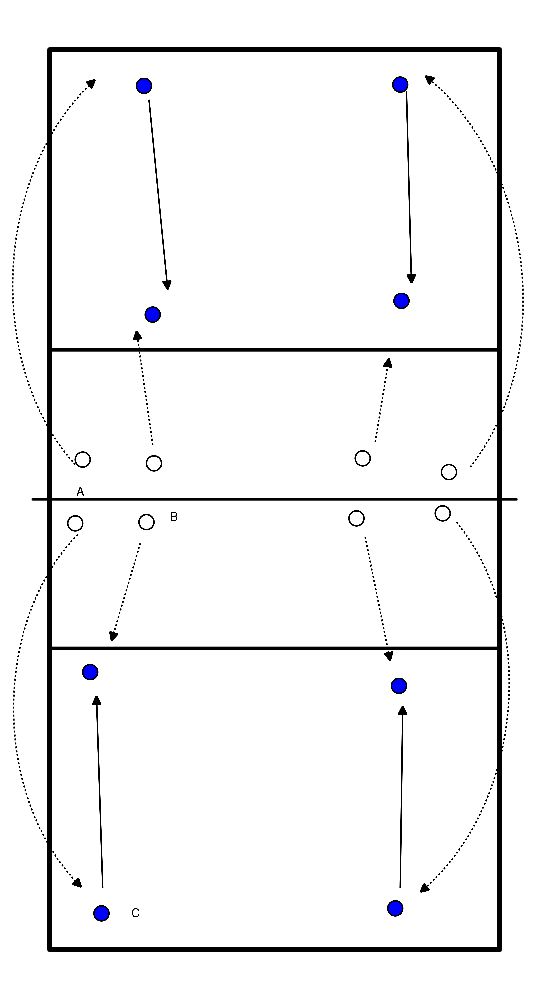
- This exercise trains the split step.
- Players line up behind the back line.
- Trainer or player stands at the net.
- One by one the players walk in from the back line.
- When the trainer hits the ball, the player makes a split step.
- Then he gets the ball on a random spot next to or in front of him.
- Player passes back and retrieves ball if necessary.
- After that the player closes in at the back.
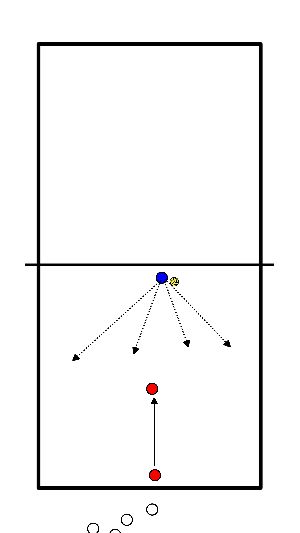
- Organisation:
- 3 players on p2, p3 and p4.
- 2 players on p5/p6 and p6/p1.
- Other players with ball on p6.
- Execution:
- BH to p4 and follow ball, from p4 BH to p5/p6, follow ball backwards.
- From p5/p6 OH to p3 and follow through, etc.
- At p2 catch and connect to p6.
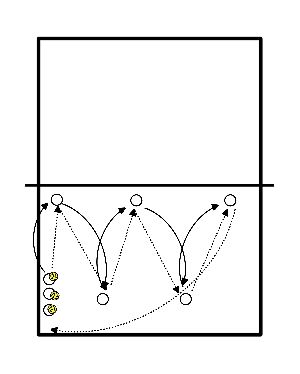
- Organization:
- 2 groups, 1 on each half.
- Service from p1/p6 on 2 passers on P5 and P6.
- Catcher on P2.
- Execution:
- Service on the 2 passers, call "loose".
- Server passes to other court.
- Pass to p2/3 and catch.
- Catcher goes to serve.
- Passer runs ball behind.
